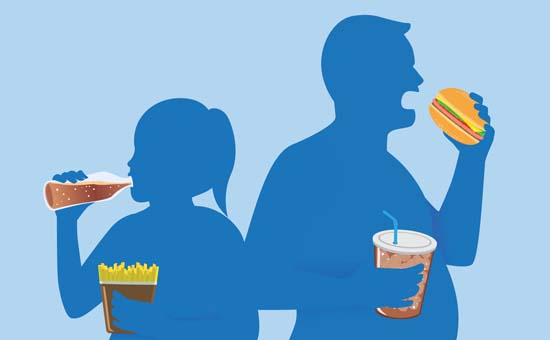Diabetes-associated self-destruction mechanism
Postprandial hyperglycemia or high blood sugar after a meal can be harmful to the body more than having a constantly high blood sugar level. Let us explore below why this is so.
Exploring deeper
There are 2 types of toxins resulting from high sugar intake. After-meal hyperglycemia is associated with glycation where glucose combines with protein and lipids in the bloodstream and forms advance glycation end products (AGEs). AGEs are accumulated in cells, such as eye blood vessel cells, cardiovascular cells and renal artery cells. Accumulated AGEs on cell walls stimulate reactive oxygen species which produce pro-inflammatory cytokines outside the cells. The reactive oxygen species produces staining and glycotoxins. The second toxin is advance lipoxidation end products (ALEs). Both AGEs and ALEs damage cells wherever too much of them accumulate.
Glycotoxins are a key factor of degenerative disease, as hemoglobin with glycotoxins cannot transfer oxygen to body cells. Large amounts of glycotoxins are found among patients suffering diabetes, kidney disease, heart disease, cancer and deteriorating nervous system. The percentage of hemoglobin attached with glycotoxins can be detected by the Hemoglobin A1c (HbA1c) test.
Aside from glycotoxins which the body creates upon high levels of blood sugar, glycotoxins can also be found in many kinds of foods cooked with high temperature. Foods with additives and pasteurized / sterilized foods also contain glycotoxins. Foods with high glycotoxins include Cola, baked foods, caramel, beer and the likes of them.
In diabetes patients, glycotoxins accumulate in their hemoglobin and hinder its function thereafter. Glycotoxins accumulated in the eye cause macular degeneration. Glycotoxins accumulated in the nerve cause peripheral neuropathy. Glycotoxins accumulated in the kidney tissues impede kidney functions.

Food selection as preventive measures against Glycation and Glycotoxin
Simple rules are as follows:
1. Avoid foods with high fat and protein
2. Avoid foods cooked with high temperature
Foods with high fat and protein, such as meat and seafood and foods with high fructose, when cooked with high temperature, will produce high amounts of glycotoxins.
Therefore, cooking methods with high temperature like roasting, frying, grilling and more should be avoided. The cooking methods with low temperature like boiling, steaming, stewing or simmering would be healthier choices. The heat which causes brown coloring on the surface food cooked at high temperature is the effect of glycotoxins. Although the body does not absorb the majority of glycotoxins (70% of glycotoxins from foods are not absorbed into the body and the 30% of absorbed glycotoxins is excreted with urine), the residue can be accumulated in the body tissues.

Dining out
To prevent glycotoxins, you should select boiled, steamed, simmered foods or salad. You may prepare healthy salad dressing made of olive oil or flaxseed oil from home. Avoid carbonated drinks, foods with caramel, foods cooked with high temperature or baked foods, such as cakes and cookies.
Aside from avoiding glycation and glycotoxins, natural antioxidants and anti-glycation substances in fruits and vegetables should be added. Dr. Terry Wahls a clinical professor at Iowa University and the author of the acclaimed book “Wahls Protocol” which tabulates her recovery from progressive Multiple Sclerosis (MS) through diet and lifestyle changes is a phenomenal case study. She calculated the amount of vitamins classified as antioxidants in vegetables. To adequately prevent diseases, consuming the following comes highly recommended:
-
3 cups of green vegetables
-
3 cups of colorful vegetables (violet, yellow, orange and more)
-
3 cups of vegetables with sulfur, such as broccoli, cauliflower, cabbage, Chinese kale, curl leaf kale, shallot, onion, garlic, spring onion, coriander, daikon, bitter bean and asparagus
The recommendations made above was in line with the recommendation of the American Heart Association which suggested taking 7 cups of vegetables per day. However, if you cannot have 7-9 cups of vegetables every day, dietary supplements from natural extracts could be an alternative. Although dietary supplements cannot compare to natural fruits and vegetables, they can be a beneficial contribution to your health.

In cases when diabetes is not effectively controlled, the patient should have additional nutrients, such as garlic, chromium, five-leaf ginseng and balsam apple. Benfotiamine and Carnosine can also assist in reversing the glycation effect. Healthy foods, together with daily exercise, may result in less medications and in addition also reduce the risk of complications.
The information and studies mentioned above reaffirms the facts that disease knowledge and patient education are important factors for those managing diabetes and for anyone who is keen on good health. The self-destructing mechanism caused by diabetes and implications being insulin resistance can significantly affect the organ systems. Therefore with the right treatment approach plus an in-depth understanding of the disease, an optimal curative path is a reality.




Sign In
Create New Account